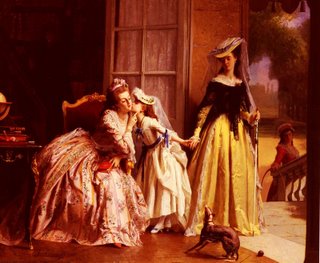 Once a week on this blog there will be a cameo of certain friends and relatives of Marie-Antoinette and Louis XVI, those who might have indeed "taken tea" at Petit Trianon. The queen's closest confidante was Madame de Polignac. Gabrielle de Polastron, Duchesse de Polignac, also referred to as "Yolande," is usually portrayed in books and films as Marie-Antoinette's "bad girl" friend, responsible for leading the young queen of France into a wild, decadent lifestyle. Often depicted as a greedy, spendthrift slut, Gabrielle preferred simplicity, was a devoted mother and loyal friend of both the Louis and Antoinette. Part of the rehabilitation of Marie-Antoinette's reputation is a careful look at her relationship with Gabrielle.
Once a week on this blog there will be a cameo of certain friends and relatives of Marie-Antoinette and Louis XVI, those who might have indeed "taken tea" at Petit Trianon. The queen's closest confidante was Madame de Polignac. Gabrielle de Polastron, Duchesse de Polignac, also referred to as "Yolande," is usually portrayed in books and films as Marie-Antoinette's "bad girl" friend, responsible for leading the young queen of France into a wild, decadent lifestyle. Often depicted as a greedy, spendthrift slut, Gabrielle preferred simplicity, was a devoted mother and loyal friend of both the Louis and Antoinette. Part of the rehabilitation of Marie-Antoinette's reputation is a careful look at her relationship with Gabrielle.Gabrielle, born in September 1749, came from an old family of Languedoc. After her mother's death when she was three, Gabrielle was given to the care of an aunt, Madame d'Andlau. While still a small child Gabrielle was placed in a convent school, where she grew up. Now many girls of high and low estate were educated by nuns in those days, including Louis XV's mistress Madame du Barry. In Gabrielle's case, perhaps because she was separated from her family at such an early age, there seems to have some influence of the religious life in her personal habits. She wore simple, tasteful clothes, never wore perfume or flashy gems, such as diamonds. Cheerful and discreet, a lover of music and the outdoors, Gabrielle grew into a refined lady of enchanting grace and beauty.
At the age of eighteen Gabrielle, was given in marriage to Comte Jules be Polignac of an ancient family of Auvergne. Since the twenty-two year old bridegroom was a captain in the Royal Pologne regiment, they moved to Paris. According to Edmond Giscard d'Estaing in the June 1977 Historia magazine (translated by a Belgian friend):
This young couple had a fortune, but they also had the charges of the poor members of their family, so that they could not afford Versailles.... So they remained with Polignac's father or Madame d'Andlau, in the Louvre or at Claye. This young woman enjoyed living in the country, and would have stayed there for her entire life without Diane de Polignac's intervention. Diane, her sister in law, was not very pretty, but she was clever, ambitious, and gifted for intrigues.
In 1774, in the beginning of the reign of Louis XVI, Gabrielle met Marie-Antoinette, and as Diane had hoped, Gabrielle's charming, easy-going manner captivated the eighteen year old queen, who was struggling with the iron restraints of the court etiquette. Antoinette had been sent to France as Louis' bride in order to further Austrian interests. Louis XVI, however, did not want his wife to meddle in politics, knowing that as a foreigner it could lead to her unpopularity. He feared to replicate the pattern of his grandfather Louis XV's reign, in which at times it seemed like Madame de Pompadour was ruling France. He also wanted to keep her from manipulation by the various factions at court, especially the liberal Orleanist clique. Authors such as Philippe Delorme, Girault de Coursac, and Bernard Fay maintain that Louis XVI encouraged his wife to befriend Gabrielle, and so created for her a circle of politically "safe" friends.
Marie-Antoinette also needed a calm, motherly companion, older than herself, to advise her about her difficulties in her marriage, her fears about pregnancy and childbirth. Gabrielle was such a friend, soothing the queen in her moments of hysteria and depression. Louis XVI held her in high regard, and gave a high office to her husband so that the Polignacs could afford to live at court. Madame de Polignac was the only person Louis XVI ever visited in a private home; he sat with her at the opera, and wrote to her when she left Versailles. As the royal family grew, the king and queen entrusted Gabrielle with their children, being that she had showed herself to be an exemplary mother of her own three. Gabrielle influenced the queen to adopt simpler styles. At Gabrielle's home and with her family, Marie-Antoinette said, "Here I truly feel at home."
According to Giscard d'Estaing, the "salon Polignac" soon provoked envy and calumny among the courtiers who were excluded from the queen's circle.
Among men in this circle, the first place was for "divine Vaudreuil," the most faithful of knights and adorers of Yolande de Polignac. This 40 years old Creole, with his face marked by smallpox, was noticeable for his entire devotion, but also for his sparkling wit, and his constantly imagining new parties, new spectacles... .Another lively person was Besenval, this greyheared Swiss, somewhat heavy, however so flexible and smart, and loyal. Fersen, this young romantic Swede, so elegant with his languid eyes, was among the most frequent too. "Handsome Fersen" and "divine Vaudreuil" played, the one towards the queen, the other one towards the duchess Jules, the same roles, that calumny arose, without convincing anyone other than those who wanted to be convinced.
But sumptuous Versailles was not built for this light existence.... this isolated little circle provoked rumors, that would soon get venomous. If the whole court was invited to the great balls organized at Versailles, only a few intimates were allowed in Madame de Polignac's salon, and this even more when the queen stayed at Trianon. Soon arose terrible criticisms and awful calumnies....The necklace affair is the most characteristic way calumny was used... The whole city of Paris was passionate about this affair, pamphlets went from hand to hand and, while the queen was so obviously totally innocent, public opinion considered her guilty, so that, even today, the queen seems to have been part to this scandal.
Marie-Antoinette was terribly upset. Madame Campan told what happened when she heard that the Cardinal had been released. "The queen cried and sobbed. 'Ah ! I feel like dying ! Ah ! Those wicked people ! What have I done to them ? If you love me, you'd better kill me !' Then, she asked for 'her friend, her dear Polignac,' who would console her. Within 10 minutes, Madame Campan wrote, she was beside the queen. She immediately entered the room. The queen stretched her arms towards her, and she ran to her. I still heard sobbing, and I went out.
The Polignacs were accused of greediness, but they were probably not anymore greedy than any other family. As Giscard d'Estaing writes:
The gifts [Madame de Polignac] received were insignificant besides those which courtiers, lords and, a fortiori, members of the royal family, were massively given. Sums Louis XIV and Louis XV spent for favorites or for palaces that were liberally distributed are considerable, and we are astonished to see how legend focuses on Yolande de Polignac only, and reproaches her, the most innocent of all, forgetting about all the other people.
The calumnies grew uglier as the propaganda machine, aimed at provoking the revolution, produced porngraphic pamphlets depicting Antoinette and Gabrielle as lesbian lovers, engaged in orgies at Trianon. Gabrielle became universally detested and was blamed for depleting the royal treasury, although it was war that had caused the bankruptcy. She "often asked to retire from the court. 'I am not made for living at Versailles,' she kept repeating."
The king wished to reform the feudal tax system and get rid of the deficit by taxing the nobility, and so he called the Estates-General in May 1789. The opening of the Estates General coincided with the death of the king and queen's seven year old son, the Dauphin Louis-Joseph. The royal couple were devastated and with difficulty met the escalating crisis. When violence erupted on July 14, 1789, Antoinette begged her friend to leave, fearing that she would be assassinated. Gabrielle begged not to abandon Louis and Antoinette in their hour of need, but the queen said, "Remember that you are a mother." On July 16, the Polignac family left Versailles for a life of exile.
Gabrielle's health deteriorated. She had cancer as well as being consumed with horror and anxiety as she heard of the imprisonment and tragedies that befell Louis and Antoinette.
One of her friends wrote: "She did not stop crying. For six months, a deep sadness, great sufferings without certain causes weakened her each day more." A last blow hit her when they were forced to announce to her this horrible news: on October, 16th, 1793, Marie-Antoinette had been beheaded in Paris. This was the true beginning of Madame de Polignac's agony. She could not survive the queen, and she herself died on December, 9th, 1793, one month and a half, precisely, after her friend.
A witness told of her death: "Her last sigh was but her last breath, and to tell this in one word, her death was as sweet as she herself had been. She was buried in Vienna and they wrote on her tomb her name only, followed by this mention: 'Dead from suffering' on December 9th, 1793."
I am more and more convinced that Gabrielle has been just as maligned as the queen. What went on with her relations and friends was a common occurence in a every court of Europe - when you rose, your family rose with you, it was almost expected. If there had been no revolution, no one would have given a second thought to the Polignacs, except perhaps to find them annoying, as many did. But with the complete upheaval of society in the Revolution, contemporaries and historians alike were/are grasping for straws to see what the queen did that made her so hated by the French people. They think it must have been the problems with La Barry, or the queen's dress allowance, or her Trianon, or Gabrielle's grasping relatives, etc.
However, Marie-Antoinette was hated because she was deliberately maligned by a careful campaign on the part of political enemies, which included dissimulating false and exaggerated rumors to the people, as well as every form of the most vile pornography. Gabrielle was routinely included in the pornograhic depictions. People were scandalized and believed that some of it must be true. Gabrielle must have done something wrong. To this day Gabrielle is seen as the naughty, greedy friend, when in reality she probably saved Antoinette's sanity. The powerful tools used to destroy the French monarchy and transform society into a totalitarian state are with us still, but on a much larger and more pervasive scale. Share
























